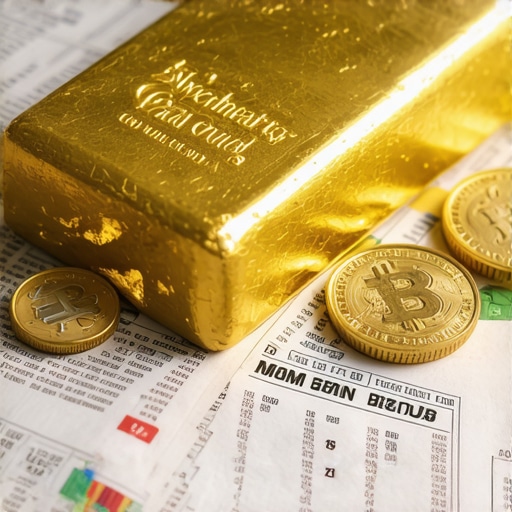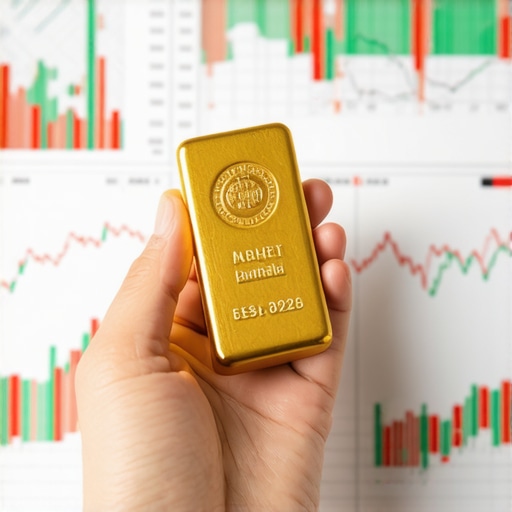Introduction to Investing in Gold for Beginners
Investing in gold has long been regarded as a reliable strategy for safeguarding wealth and diversifying investment portfolios. In uncertain economic times, gold often acts as a safe haven, providing stability against inflation and market volatility. For those new to this precious metal investment, understanding the basics is crucial to making informed decisions. Here are five essential tips to consider when embarking on your gold investment journey.
1. Understand the Different Types of Gold Investments
Before diving in, it’s important to familiarize yourself with the various forms of gold investments available. These include physical gold, such as gold coins and bars, and financial products like gold ETFs and mutual funds. Each type has its own set of advantages and risks. For example, physical gold allows you to possess a tangible asset, while gold ETFs offer liquidity and ease of trading.
2. Set a Clear Investment Strategy
Having a well-defined strategy is crucial for any successful investment endeavor. Determine your financial goals, risk tolerance, and the amount of capital you wish to allocate to gold. Are you looking for short-term gains, or are you more interested in a long-term store of value? Understanding your investment horizon will help guide your decisions and keep your objectives on track. For beginners, starting small may be a wise approach.
3. Research Gold Market Trends
Keeping an eye on market trends is essential for making informed gold investment decisions. Factors like global economic conditions, inflation rates, and geopolitical tensions can significantly influence gold prices. It’s vital to stay updated on current events and economic reports to anticipate market movements. For detailed insights, check out current gold demand trends to understand what influences the market.
4. Choose a Reputable Dealer
When buying physical gold, selecting a trustworthy dealer is paramount. Look for dealers with a solid reputation, transparent pricing, and positive customer reviews. Additionally, ensure that the dealer is knowledgeable about gold investments and can provide guidance. For a list of reliable dealers, refer to our post on top gold dealers to trust in 2025.
5. Keep an Eye on Storage Options
Lastly, if you choose to invest in physical gold, consider your storage options carefully. Proper storage is essential to protect your investment from theft or damage. Options include home safes, safety deposit boxes, or professional storage services. Each comes with its own costs and benefits, so evaluate what works best for you. For more on this topic, see our guide on storing physical gold.
Understanding Gold Market Dynamics
As a new investor, grasping the intricacies of the gold market is crucial. Gold prices are influenced by various factors, including supply and demand, economic indicators, and investor sentiment. For instance, during economic downturns, gold often sees increased demand due to its status as a safe haven. This makes it essential to monitor current gold demand trends to make informed decisions.
6. Diversify Your Gold Investments
While investing in gold is a solid strategy, diversifying your investments can help mitigate risks. Consider adding different types of gold investments to your portfolio, such as gold stocks, ETFs, and physical gold. By spreading your investments across various forms, you can reduce the impact of market volatility on your overall portfolio. For insights on the best gold stocks to consider, check out evaluating the best gold stocks for your portfolio.
7. Stay Informed About Global Events
Global events can have a significant impact on gold prices. Geopolitical tensions, trade policies, and economic changes can lead to price fluctuations. To navigate these shifts effectively, it’s vital to stay informed about major global developments. Following reliable news sources and financial analysts can help you anticipate potential market changes. For a deeper understanding of how these factors influence gold, explore our article on how global events shape gold demand trends.
8. Be Mindful of Fees and Taxes
When investing in gold, it’s crucial to be aware of the associated fees and taxes. Different types of gold investments come with varying costs, such as dealer premiums, storage fees, and potential capital gains taxes. Understanding these costs upfront can help you calculate your overall investment return accurately. For more information on this topic, refer to our guide on understanding gold’s role in economic uncertainty.
9. Monitor Your Investments Regularly
Investing in gold, like any other investment, requires regular monitoring. Keep track of your portfolio and review your investment strategy periodically. This will help you identify when to buy, sell, or hold your assets based on market conditions and personal financial goals. For tips on analyzing market trends effectively, check out our post on how to analyze gold market trends like a pro.
10. Consider the Long-Term Perspective
Finally, remember that investing in gold should be viewed as a long-term strategy. While short-term fluctuations in price can be tempting to react to, a long-term focus can help you weather market volatility and achieve your financial goals. Gold has historically proven to be a reliable store of value over time. For a comprehensive look at gold price forecasts, you may want to read 2025 gold price forecast predictions you can’t miss.
9. Monitor Your Investments Regularly
Investing in gold, like any other investment, requires regular monitoring. Keep track of your portfolio and review your investment strategy periodically. This will help you identify when to buy, sell, or hold your assets based on market conditions and personal financial goals. For tips on analyzing market trends effectively, check out our post on how to analyze gold market trends like a pro.
10. Consider the Long-Term Perspective
Finally, remember that investing in gold should be viewed as a long-term strategy. While short-term fluctuations in price can be tempting to react to, a long-term focus can help you weather market volatility and achieve your financial goals. Gold has historically proven to be a reliable store of value over time. For a comprehensive look at gold price forecasts, you may want to read 2025 gold price forecast predictions you can’t miss.
Understanding Gold Market Dynamics
As a new investor, grasping the intricacies of the gold market is crucial. Gold prices are influenced by various factors, including supply and demand, economic indicators, and investor sentiment. For instance, during economic downturns, gold often sees increased demand due to its status as a safe haven. This makes it essential to monitor current gold demand trends to make informed decisions.
11. Diversify Your Gold Investments
While investing in gold is a solid strategy, diversifying your investments can help mitigate risks. Consider adding different types of gold investments to your portfolio, such as gold stocks, ETFs, and physical gold. By spreading your investments across various forms, you can reduce the impact of market volatility on your overall portfolio. For insights on the best gold stocks to consider, check out evaluating the best gold stocks for your portfolio.
12. Stay Informed About Global Events
Global events can have a significant impact on gold prices. Geopolitical tensions, trade policies, and economic changes can lead to price fluctuations. To navigate these shifts effectively, it’s vital to stay informed about major global developments. Following reliable news sources and financial analysts can help you anticipate potential market changes. For a deeper understanding of how these factors influence gold, explore our article on how global events shape gold demand trends.
13. Be Mindful of Fees and Taxes
When investing in gold, it’s crucial to be aware of the associated fees and taxes. Different types of gold investments come with varying costs, such as dealer premiums, storage fees, and potential capital gains taxes. Understanding these costs upfront can help you calculate your overall investment return accurately. For more information on this topic, refer to our guide on understanding gold’s role in economic uncertainty.
14. Explore Gold Investment Types
Diving deeper into the various types of gold investments can help you make better choices. Each type offers unique benefits and risks. For example, gold bullion is a popular choice for those seeking physical assets, while gold mining stocks can provide exposure to the industry’s performance. For more on this topic, see our article on the ultimate guide to different types of gold investments.
14. Explore Gold Investment Types
Diving deeper into the various types of gold investments can help you make better choices. Each type offers unique benefits and risks. For example, gold bullion is a popular choice for those seeking physical assets, while gold mining stocks can provide exposure to the industry’s performance. For more on this topic, see our article on the ultimate guide to different types of gold investments.
15. Understand Gold Trading Techniques
Mastering gold trading techniques is essential for maximizing your profits in this market. Strategies such as technical analysis, understanding market trends, and timing your buys and sells can significantly impact your returns. For insights on trading effectively, explore our post on gold trading techniques: 5 steps to enhance your skills.
16. Importance of Timing in Gold Investments
Timing your gold investments can be crucial in achieving favorable outcomes. Since gold prices fluctuate based on market conditions, being aware of the right time to invest can lead to better returns. Keeping an eye on market forecasts and expert predictions can help you navigate this aspect effectively. For a detailed forecast, refer to 2025 gold price forecast predictions you can’t miss.
17. Risk Management in Gold Investments
Like all investments, gold carries inherent risks. Implementing a sound risk management strategy is vital for protecting your portfolio. This includes diversifying your investments, setting stop-loss orders, and regularly reviewing your portfolio’s performance. To learn more about effective risk management, see our article on evaluating your gold investment strategy for 2025.
18. The Role of Gold in Economic Uncertainty
Gold has historically been viewed as a safe haven during times of economic uncertainty. Understanding gold’s role in economic fluctuations can help investors make informed decisions. As global events unfold, gold prices often react to shifts in investor sentiment. For a deeper dive into this phenomenon, check out our piece on understanding gold’s role in economic uncertainty.
19. The Future of Gold Investments
The future of gold investments looks promising, especially in light of ongoing economic challenges. Analysts anticipate that demand for gold will continue to rise as investors seek stability in their portfolios. Staying informed about market trends and future forecasts can position you advantageously in this dynamic landscape. For up-to-date information, refer to our article on 2025 outlook: key predictions for gold price trends.
Conclusion: Making Informed Gold Investment Decisions
In conclusion, investing in gold requires a comprehensive understanding of the various investment types, market dynamics, and risk management strategies. By educating yourself on these aspects, you can make informed decisions that align with your financial goals. Whether you’re a beginner or an experienced investor, staying updated on gold market trends is essential to maximize your investment potential. For a complete roadmap to getting started with gold investments, visit investing in gold for beginners: your complete roadmap.
Frequently Asked Questions About Investing in Gold
1. What is the best way to invest in gold for beginners?
For beginners, the best way to invest in gold is to start with gold ETFs or gold mutual funds as they offer liquidity and diversification. Physical gold, such as coins and bars, is also an option but requires additional considerations for storage and insurance.
2. How much should I invest in gold?
Investment in gold should depend on your overall portfolio strategy. A general recommendation is to allocate 5-10% of your total investment portfolio to gold, which can serve as a hedge against inflation and market volatility.
3. Is investing in gold safe?
While gold is considered a safe haven asset, it is not without risks. Prices can fluctuate based on market conditions, and there are costs associated with buying, storing, and selling physical gold. However, gold typically retains value during economic downturns.
4. How do I determine the right time to buy gold?
Timing your gold investments can be challenging. Monitoring economic indicators, market trends, and geopolitical events can provide insights into when to buy. Consulting expert predictions and forecasts can also be beneficial.
5. What are the tax implications of investing in gold?
Investing in gold can have tax implications, such as capital gains taxes on profits when selling gold. The tax rate may vary based on how long you hold the investment. It’s advisable to consult a tax professional for specific guidance.
6. Can I invest in gold through my retirement account?
Yes, you can invest in gold through a self-directed IRA that allows physical gold investments or gold ETFs. This can provide tax advantages, but ensure you understand the rules and regulations governing such accounts.
7. What are the risks of investing in gold mining stocks?
Investing in gold mining stocks can be riskier than owning physical gold. Mining stocks can be affected by operational issues, management decisions, and fluctuating gold prices. It’s essential to research companies and understand their financial health before investing.
8. How does inflation affect gold prices?
Gold is often viewed as a hedge against inflation. When inflation rises, the purchasing power of currency decreases, leading investors to flock to gold, which typically increases its price. Monitoring inflation rates can provide insight into potential gold price movements.
9. What should I look for in a gold dealer?
When choosing a gold dealer, look for a reputable company with positive customer reviews, transparent pricing, and industry certifications. Check for affiliations with recognized organizations, such as the Professional Numismatists Guild or the American Numismatic Association.
10. How do I store physical gold safely?
Storing physical gold safely is crucial. Options include secure home safes, bank safety deposit boxes, or professional storage services. Assess the costs and benefits of each option to determine what works best for your investment.
Authority Resources for Gold Investment
For those looking to dive deeper into gold investments, consider exploring these trusted resources:
- Kitco – Precious Metals News and Prices
- World Gold Council – Research and Insights on Gold Investment
- Investopedia – Comprehensive Guides on Gold Investing
- Forbes – Insights and Analysis on Gold Market Trends
- BullionVault – Buy and Sell Gold and Silver Online
Conclusion: Empowering Your Gold Investment Journey
In summary, investing in gold offers a unique opportunity to diversify your portfolio and safeguard your wealth. By understanding the types of gold investments available, staying informed about market dynamics, and utilizing sound investment strategies, you can navigate this precious metal’s landscape effectively. Whether you’re a beginner or an experienced investor, leveraging the insights and resources provided will enhance your ability to make informed decisions. Remember, gold remains a valuable asset in uncertain times, making it a wise addition to your investment portfolio.










I’ve recently delved into gold investing, and I completely resonate with the points raised in this article, especially the importance of understanding different types of gold investments. At first, I was inclined to buy physical gold, but after weighing the pros and cons, I’ve opted for a mix that includes gold ETFs. This approach has provided me with the liquidity I need while still allowing me to tap into the stability that physical gold offers.
Moreover, setting a clear investment strategy is an absolute game changer. I initially jumped into buying without a concrete plan, which led to some regretful decisions. Now, I approach it with a well-defined goal and a specific allocation percentage of my portfolio, typically around 8%.
Lastly, I think it’s crucial to regularly monitor investments and market trends, as you mentioned. Economic shifts can change everything, and staying updated helps me make timely decisions. For anyone new, starting small and diversifying can really help alleviate the stress that comes with investing. Anyone else here have their own strategies or experiences with gold investments?
I can definitely relate to the learning curve of investing in gold. When I first started, I was overwhelmed by the types of investments available. It’s interesting to note, while physical gold feels like the safe and secure option, I’ve found that gold-backed ETFs can sometimes yield more flexibility, especially for beginners. They allow for easier buying and selling, which has been beneficial for my portfolio.
One key point that struck me is the storage aspect of physical gold. I underestimated the importance of securing my investments and initially thought that just locking it up at home would suffice. I later realized that using a safety deposit box was a much safer alternative, albeit at an extra cost.
Setting a clear investment strategy has played a vital role in my decisions as well. My strategy revolves around market analysis and staying informed about global events, which helps me to react to shifts in the gold market effectively. Watching trends and adjusting my investments accordingly has truly been eye-opening. What’s fascinating to me is how many investors overlook the importance of a diversified strategy, which is essential to mitigate risks. Has anyone integrated other asset classes with their gold investments?
The post highlights key factors that beginners should keep in mind when investing in gold, especially around diversification and risk management, which I find crucial. In my experience, investing solely in physical gold can be limiting due to storage concerns and liquidity issues. Incorporating gold ETFs and even gold mining stocks into a portfolio not only offers diversification but also a degree of exposure to the industry’s growth potential. I also appreciate the emphasis on staying informed about global events, as geopolitical tensions can suddenly impact gold prices significantly. One aspect I’d add is the importance of tax planning related to gold investments—understanding capital gains implications early on can prevent surprises down the road. For those new to gold, starting with smaller, manageable investments and gradually diversifying seems like a balanced approach. It allows time to learn market behavior and the various gold investment vehicles before committing more capital. Has anyone found particular sources or tools especially helpful to keep track of gold price trends and market movements?